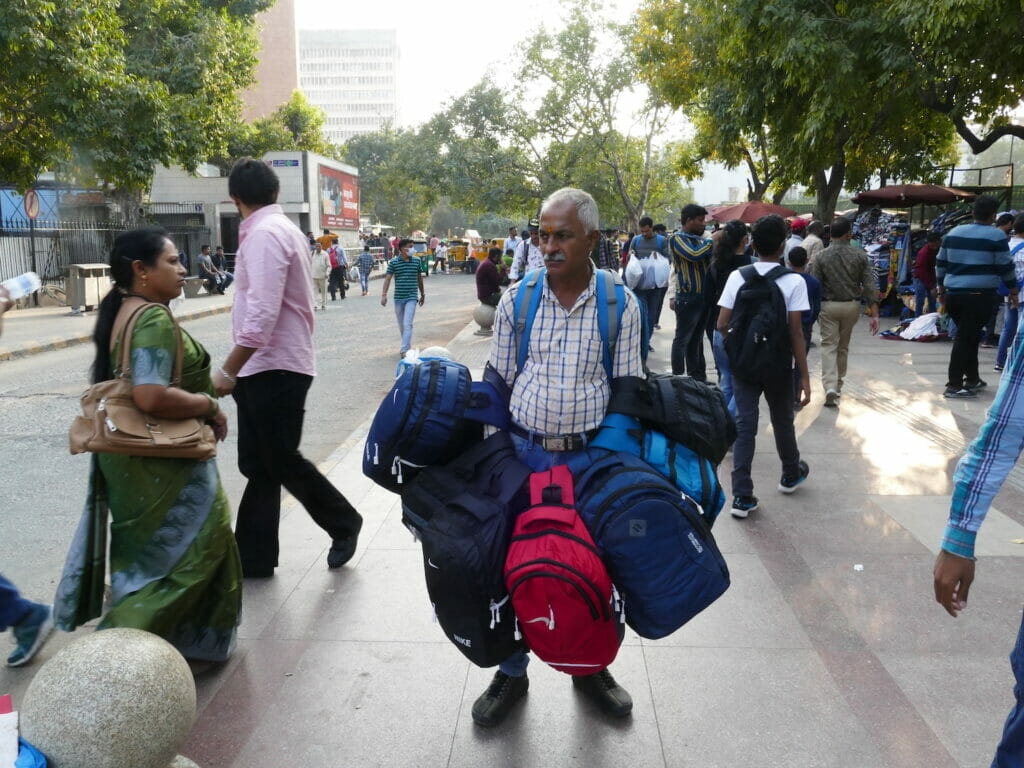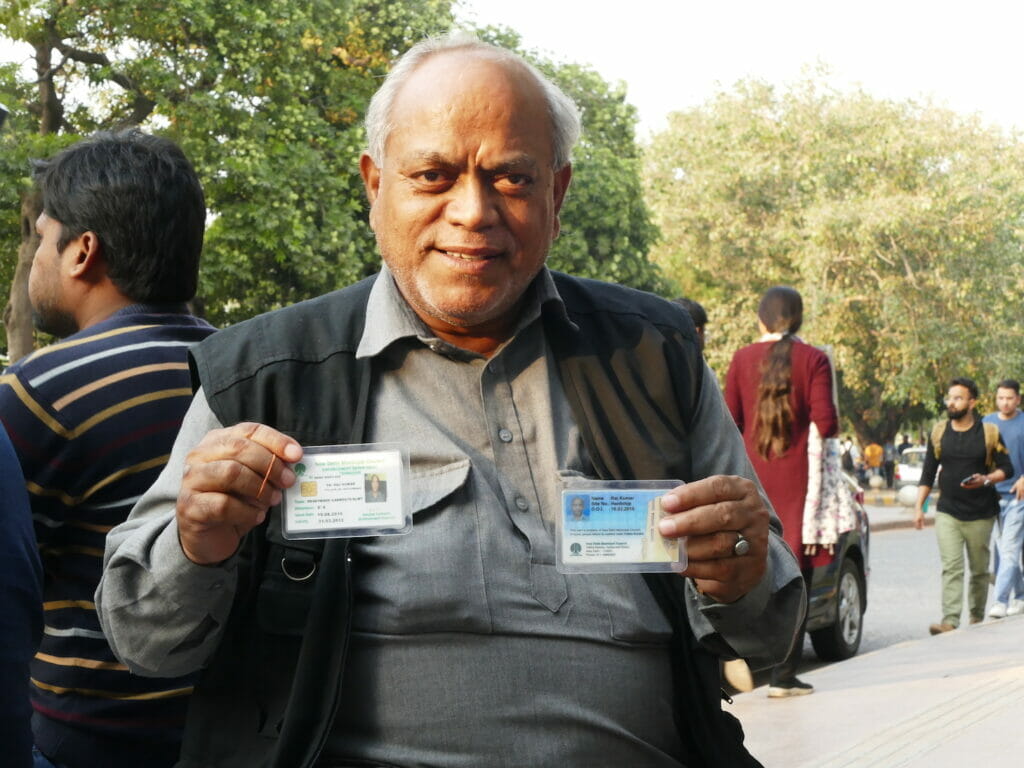This is the first of a two part story on why finding a sustainable solution to regulate Delhi’s legal and illegal street vendors is so difficult.
Ask the best-dressed girl in Lady Shri Ram College or Miranda House where she bought the smart top she is wearing, chances are she will tell you “SN (Sarojini Nagar market)”. The checked cots wool shirt or cushion covers and tablecloth with exquisite embroidery in that posh Gurugram apartment would most probably also have been “picked up “as a “bargain” or to “help the craftspersons/roadside vendors”, from the footpath in Janpath. Ditto for the cheat bags and glares, jackets, sweatshirts and sneakers sporting big brand labels, and costume jewellery.
Truth be told, much of the beautiful looking wearables would have been bought for a pittance from street vendors eking out a living in Delhi’s street pavements, particularly in some of its main shopping hubs like Connaught Place (CP), Janpath, Sarojini Nagar and Lajpat Nagar to name the more prominent ones.
These vendors have been in the news and will continue to be under the spotlight now, as the capital will keenly watch if Chief Minister Arvind Kejriwal fulfils his promise to create vending zones for street vendors. That was the tenth of his “ten guarantees” as he kicked off the Aam Aadmi Party’s manifesto for the first ever elections to the now single Municipal Council of Delhi (MCD), which the party has just won with a clear majority.
“Hawkers will get freedom from extortion,” chief minister Arvind Kejriwal had promised. “Hawkers will get to trade inside clean vending zones”.
Read more: Delhi’s smart city plans ignore the urban poor, focus only on elite areas
Who are these street vendors?
Raj Kumar, a 58-year old vendor selling T-shirts and jackets from a 6×4 feet space outside the car parking area of Palika Bazar in the middle of CP, calmly admits he has been “a “squatter for the last 42 years”. He is a former president of the Thareja Verified Tehbazari Holders. (Tehbazari, according to the definition given by the Municipal Corporation of Delhi, means using the land surface for selling anything)
According to the New Delhi Municipal Council, there were 741 vendors authorised by the Chaturvedi Committee in 1999, on the recommendation of G P Thareja, then additional district judge appointed by the Supreme Court. Before that, the Enforcement Department of the NDMC had authorised 176 vendors who are now known as “Old Tehbazari squatters”.
They were allotted spaces as “rehabilitation measure on tehbazari basis” and the plan now is to regulate them under The Street Vendor (Protection of Livelihood & Regulation of Street Vending) Act, 2014 and the Street Vendors scheme of the Delhi Government.
Raj Kumar shows the smart identity card issued to him by the New Delhi Municipal Council (NDMC) and the receipt issued to him for a payment of Rs 11,000 towards annual rent. He says he is one of 44 persons holding such cards and receipts. The card describes his “site” as “Hardship”.
Hardship is something Raj Kumar has faced since he was a little boy selling pens, pencils and the like on the pavement outside the 18th century astronomical observatory Jantar Mantar, located in the heart of Lutyens’ Delhi, and a ten-minute walk from the circular Parliament House.
“I am a street vendor, a squatter living in Burari on the outskirts of Delhi,” says Raj Kumar. “I have been sitting here outside Palika Bazar for the last 32 years. He and others are permitted to squat there till 8pm, when the NDMC staff on duty leave.”
The “illegals”
“There are also hundreds of illegal vendors who don’t have permission or identity card authorising them to squat in this area,” adds Raj Kumar. “They are a floating lot, may be 200 or 300. Their numbers increase on Sundays”.
Young boys come to Delhi to get a job and most begin by trying to sell something on these pavements and footpaths. “Everyone has to earn a living, so I don’t think there is anything wrong. They are not trying to steal or rob or do anything unlawful,” says Raj Kumar.

According to him, when the “Tehbazari” (authorised squatting) began under the Supreme Court direction in 1990, at least 5000 people wanted a foothold on the public space outside the established, big markets. In 2007, a Town Vending Committee (see box) was also set up, but that, he says, is not functioning anymore.
“Every class comes to shop at Paalika Bazar, which has about 400 shops,” says Raj Kumar, explaining why the footfall on the established markets is important for vendors. He believes that creating a vending zone far from a popular market will never solve the issue of street vendors, and the complaint that street vendors are taking away business from rent-paying shopkeepers “is misplaced”.
Many vendors I spoke to think that the AAP promise with regard to street vendors is no more than a gimmick. It is an issue that “cannot be solved the way they are looking at it, to shift vendors to a far away place, away from CP or Paalika or Sarojini Nagar”.
Read more: “Street vendors are claimants, not intruders”
Relocation: A tricky affair
Om Narain, a vendor selling jackets from under a tree in Sarojini Nagar market explains, “All the land in Delhi is with the Central Government, not with NDMC or Delhi government. So where will they settle us?”
Any statistic on the number of street vendors in the capital is at best a reasoned guess. Mahesh Kumar, vice president of a group of squatters in CP answers the question on how many like him, claiming, “The population of Delhi must be 2.5 to 3 crore, so there would be at least 2.5 lakh to three lakh street vendors. Here in CP and Janpath, Gol Market and Sarojini Nagar, there would be over 10,000”.
But according to AAP legislator Saurabh Bhardwaj, as of September 2021, the South Delhi Municipal Corporation had identified 23,951 street vendors, the North Delhi Municipal Corporation had counted 27,819, and the East Delhi Corporation 19577 through the now defunct town vending committees.
A defunct committee
Town vending committees were constituted by the appropriate government under section 22 of The Street Vendors (Protection of Livelihood and Regulation of Street Vending) Act of 2014, with the municipal commissioner as its chairperson, and government-nominated members representing the relevant local authority and other stakeholders like the association of street vendors, market associations and trader associations and other interests as the government deems proper.
The TVC is mandated to survey all existing street vendors within a specific period in the area under its jurisdiction, once every five years. The survey is intended to ensure that all existing street vendors identified in the survey are accommodated in the vending zones subject to a norm conforming to two and a half per cent of the population of the ward or zone or town or city. This was fixed following the city plan and the holding capacity of the vending zones.
All the stated objectives ran into major obstacles when sought to be implemented. For instance, when the street vendors in Sarojini Nagar market were allotted space in a newly created vending zone in Lakshmi Bai Nagar, about 1.5 kms away, not one vendor moved.
“Vendors need an established market place where people come,” says vendor Om Narain. “There is a Street Vendors’ Policy in Delhi. Unless that policy puts us near these established markets, the issue won’t go away”.
Ironically, harassment by the Delhi Police or the NDMC and now the MCD staff is something the street vendors have learnt to live with.

“There’s no solution to this, it’s all about exchange of money,” says Mukesh Gupta, a former office bearer of the association of traders in the Sarojini Nagar market. “It is past noon, and we have not even done boni (first sale of the day). The vendors earn about Rs 250 to 300 on every transaction, and they are transacting all the time”.
On weekends, it is difficult to enter the market. That is how crowded the market gets. Mukesh estimates that in the last three years, the number of street vendors in this market has gone up “enormously”. The general feeling among the traders is that the Delhi Police and the NDMC staff allow them to sit there in return for kickbacks.
